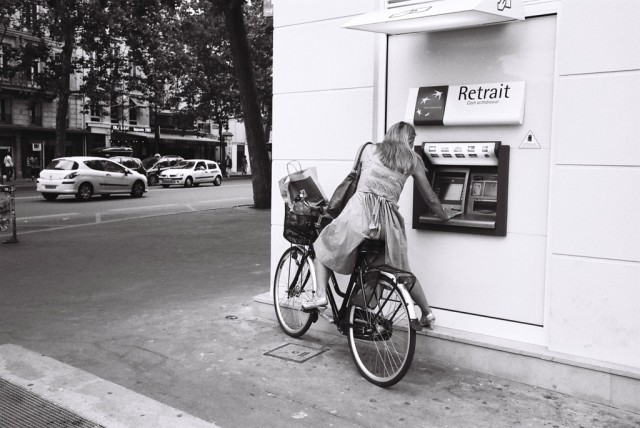How Going Cash-Only Helped Me Curb My Spending
by Bridget Dicosmo

The Problem
I never carry cash. This shouldn’t seem like a big deal, because debit cards can be cancelled if you lose them; parking meters, farmer’s markets, and even jukeboxes in the good dive-y bars all accept Visa these days.
For someone who has had the experience of clocking out of waitressing jobs and hurrying down the street at night in Queens trying hard to look like someone not carrying a bunch of low-denomination bills, sometimes just having a debit card feels safer.
And yet personal finance writers repeatedly offer numbers showing that cash-only spenders save more money than plastic hounds like me. According to a Time magazine piece by Gary Belsky and Tom Gilovich, authors of the 2010 book, Why Smart People Make Big Money Mistakes and How to Correct Them: Lessons from the Life-Changing Science of Behavioral Economics, research suggests that paying for things with credit or debit cards makes us feel removed from the notion that we’re spending money. And spending cash, Belsky and Gilovich say, makes us instantly feel a little bit poorer, making it easier to curb spending.
In those rare moments when I do have cash, I know I am definitely more money-grubbing with it when it comes to day-to-day purchases. (Example: No, you do not need a jumbo bag of the Reeses pumpkins. No one has ever needed Reeses pumpkins. No, I don’t care that they only exist one season a year. That’s not a good reason. Yes, I understand you’re at Rite Aid, and they sell Reeses pumpkins here. That’s not a good reason, either. They also sell glucose monitoring systems, and you’re not clamoring for one of those.)
The Experiment
I decided to try it out. For the first three days of the past week, I allowed myself to spend only cash, wrote down every purchase, and then did the same with my debit card the next three days.
Here’s a sample:
Day 1: Cash
Spent:
• $1 lent to coworker for vending machine purchase
• $3.99 for one carton of almond milk
Observations: I don’t take the time to actually go to the ATM as often as I should. At times when I do want cash, I too often justify purchasing magazines, gum, and things I don’t need at convenience stores so I can just use my debit card to get cash back.
Day 1: Debit Card
Spent:
• $7.50 for an egg sandwich and green juice at a deli
• $4.75 pumpkin spice latte (and a quizzical look from the Starbucks barista when I recorded the price in my notebook.)
Observations: This morning I found myself rounding up random grocery-type items: light bulbs, paper towels, etc. at the deli that I didn’t need at the moment, but, figured, “Oh, well, as long I’m here.” Then I realized I definitely would not be “stocking up” if I were spending cash, and I ended up putting everything back. I fought my spend-y demons and I won.
The Findings
Carrying cash is hard. Ok, it’s not hard, it’s … slightly inconvenient. It takes more planning and organization than I’m used to doing on a day-to-day basis to make sure I have enough cash to cover everything I may end up doing on any given day. What if I decide on happy hour plans at the last minute, and the bar is in the opposite direction from the ATM, and I’d be holding everyone up? What if I’m driving back from a friend’s house in Woodbridge and have to drive right past the Ikea there, and I finally find bar stools that would fit at the island in my kitchen? Those are the occasions where I find it difficult to resist relying on the debit card, despite my best intentions.
And I did notice a discernible difference in my inner monologue when it came down to daily purchases. “Oh, go ahead, it’ll break up the work day a little” seemed a far less tempting argument when I realized the $5 or $6 cash I was routinely spending could easily purchase a beer after work. Tiny purchases — a bottle of new nail polish here, a bubble tea there — add up quickly, and seeing the amount of cash in my wallet dwindling seemed to quiet the spend-y demons far better than my own internal back-and forth.
This got me thinking about a major takeaway from this little project: forcing myself to examine the rate at which I spend money forced me to also examine what I’m spending money on. Now, I know I don’t need a bottle of mulberry-hued nail polish just because it’s a good fall color. But I do need broccoli, and eggs, and Greek yogurt, and that’s where the overwhelmingly biggest portion of my budget, aside from rent, seems to go. And after seeing the small, unnecessary purchases start to add up, it’s pretty clear that the, “Oh, well, as long as I’m here,” mentality I mentioned earlier is affecting my grocery bill as well, and the next thing I know, I have three jars of cookie butter in my cart. So, the fix? From now on, I’m going to make an honest effort to avoid setting foot in Trader Joe’s without cash, and see if those weekly food bills don’t start dropping.
Bridget DiCosmo is a reporter living in Alexandria, Virginia, and writing for a federal policy newsletter.
Photo: Francois Karm
Support The Billfold
The Billfold continues to exist thanks to support from our readers. Help us continue to do our work by making a monthly pledge on Patreon or a one-time-only contribution through PayPal.
Comments